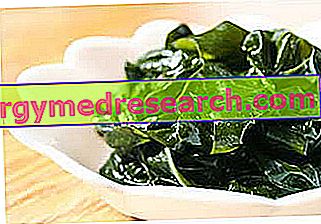What is Wakame
The Wakame ( Undaria pinnatifida ) is an edible seaweed, which together with the Laminaria ( Laminaria japonica ) represents a food resource of primary importance for the global economy, especially for the nations of East Asia and South-East Asia.

In Japan, wakame seaweed has been a very important nutritional source since 700 BC, and has been the subject of specific cultivations for several years now.
The wakame seaweed is a brown alga that grows up to about 7 meters deep, populating the rocky bottoms of the bays and sublitorals that bathe the temperate regions of Japan, Korea and China. It prefers temperatures between 5 and 18 ° C, stopping growing when the water temperature exceeds 25 ° C. Recently, wakame seaweed has spread, probably carried by the ballast waters of boats, also in France, New Zealand and Australia.
Nutritional properties
Among the various species of brown algae used for direct and indirect food purposes, Wakame is the richest source of proteins, with an average content of 16.3 grams per pound of product.
The amino acid profile and the protein quality indices are also good: wakame contains all the essential amino acids, which contribute 47.1% to the total protein content. The limiting amino acid is tryptophan; this makes the wakame seaweed a protein source complementary to the traditional sources of vegetable proteins, such as legumes and cereals.
The following tables summarize the average content of minerals, vitamins and fibers of wakame seaweed and Kombu seaweed. Alternatively, it is possible to consult the widespread source of the American Ministry of Agriculture.
| Vitamin content of Wakame seaweed ( U. pinnati fi da ) and Kombu seaweed ( L. japonica ), expressed in mg per 100 grams of dried product | |||
| Vitamin | Kombu | Wakame | DRI (Dietary Reference Intakes) * |
| β-Carotene | 2.99 ± 0.09 in | 1:30 ± 0:12 | - |
| Equivalent retinol | 0.481 ± 0.015 | 0.217 ± 0.006 | 0.65 (7.5 mg of B-carotene) |
| Vitamin B1 | 0:24 ± 0.02 | 0:30 ± 0:04 | 1.0 |
| Vitamin B2 | 0.85 ± 0:08 | 1:35 ± 0:09 | 1.1 |
| Vitamin B6 | 0:09 ± 0.01 | 0:18 ± 0.02 | 1.4 |
| Niacin | 1:58 ± 0:14 | 2:56 ± 0:11 | 12 |
| Dietary fiber content of Wakame seaweed ( U. pinnati fi da ) and Kombu seaweed ( L. japonica ), expressed as a percentage of dry weight | ||
| Fiber | Kombu | Wakame |
| Soluble | 32.6 | 30 |
| Insoluble | 4.7 | 5.3 |
| Total | 37.3 | 35.3 |
| Mineral content of Alga wakame ( U. pinnati fi da ) and alga Kombu ( L. japonica ), expressed in mg per 100 grams of dried product | |||
| Mineral | Kombu | Wakame | DRI (Dietary Reference Intakes) * |
| Football | 880 ± 20 | 950 ± 30 | 800 |
| Magnesium | 550 ± 15 | 405 ± 10 | 350 |
| Phosphorus | 300 ± 10 | 450 ± 12 | 580 |
| Iodine | 170 ± 5.5 | 26 ± 2.4 | 0, 095 |
| Sodium | 2532 ± 120 | 6494 ± 254 | 1500 |
| Potassium | 5951 ± 305 | 5691 ± 215 | 4700 |
| Nickel | 0.325 ± 0.020 | 0.265 ± 0.015 | - |
| Chrome | 0.227 ± 0.073 | 0.072 ± 0.026 | 0035 |
| Selenium | 00:05 | 00:05 | 0055 |
| Iron | 1:19 ± 0.03 | 1:54 ± 0:07 | 150 |
| Zinc | 0.886 ± 0.330 | 0.944 ± 0.038 | 11 |
| Magnesium | 0.294 ± 0.017 | 0.332 ± 0.039 | 420 |
| Copper | 0.247 ± 0.076 | 0.185 ± 0.016 | 0.9 |
| Lead | 0.087 ± 0.021 | 0.079 ± 0.015 | - |
| Cadmium | 0.017 ± 0.007 | 0.028 ± 0:00 | - |
| Mercury | 0.054 ± 0.005 | 0.022 ± 0.003 | - |
| Arsenic | 0.087 ± 0.006 | 0.055 ± 0.008 | - |
Benefits and properties
While in the countries of origin it is habitually consumed as a food, its excellent nutritional profile means that in the West Wakame seaweed is marketed mainly as a food supplement.
For the Vegan Diet
The excellent protein content and the good quality of the proteins make it the subject of an advertising promotion that depicts it as the ideal complement to the vegetarian diet in its various forms and the macrobiotic one. Basically, the wakame seaweed can be considered a tonic, a useful aid to reach the needs of the various nutrients in case of food shortages or increased needs. Vitamin and mineral deficiencies, weakness, fragility of nails and hair, tiredness and reduced concentration, are the classic indications of supplements based on wakame seaweed.
For Slimming Diets
The commercial boost to the consumption of Wakame algae also and above all derives from the alleged slimming properties, with stimulation of energy expenditure.
Iodine and Selenium
The physiological basis of these characteristics is to be found first of all in the excellent content of iodine and selenium, two essential minerals for the correct functionality of the thyroid, which with its hormones directly influences the body's metabolism.
Fucoxantina
In second analysis, like other Brune algae, wakame seaweed is a well-known source of fucoxanthin, a carotenoid that appears to activate the UCP1 decoupling protein. This protein - particularly expressed in brown fat - promotes the oxidation of fats to generate heat, "burning them" and preventing them from being deposited as a fatty reserve.
This effect, now well established on laboratory mice, is awaiting clinical confirmation in humans: it is believed, however, that the bioavailability and absorption of fucoxanthin contained in the wakame seaweed are rather modest.
Soluble fibers
Due to the richness in soluble fibers (alginates), the wakame seaweed can promote weight loss also through the satiating effect given by the swelling of these colloidal fibers in contact with water inside the stomach. The distension of the gastric walls is in fact one of the signals that favor the onset of the sense of satiety, removing the pangs of hunger. Still at the gastric level, the alginates help to form a sort of protective film on the stomach walls, protecting them from the acid insult of gastric juices; not surprisingly, alginates are used in problems of gastric acidity and gastroesophageal reflux.
Probably these characteristics also explain the results of a recent study, according to which the daily consumption of 4/6 grams of seaweed, typical of most Japanese, can be associated with a low incidence of metabolic syndrome. These benefits would be amplified by the generous presence of marine fish in the diet, also typical of Japanese cuisine.
Tofu with Alga Wakame
X Problems with video playback? Reload from YouTube Go to Video Page Go to Video Recipes Section Watch the video on youtubeMode of use
Recommended intake doses
The recommended intake rates are generally between two and four grams of dried wakame seaweed per day. Of course, such low contributions significantly reduce the actual amount of beneficial nutrients assumed through Wakame's integration, making only the intake of iodine meaningful.
Iodine and Side Effects
Alga Wakame as a supplement of Iodine
Among the most significant and characteristic nutrients of the Iga wakame is iodine. The recommended daily intake of this mineral is 90-150 mcg, a quantity that - given by hand - is covered by the simple ingestion of 557 mg (0.557 grams) of dried wakame seaweed.
The maximum dose of iodine that presumably does not cause harm to a healthy individual is 1100 mcg per day, a threshold that would be exceeded by the consumption of wakame algae in doses higher than 4.23 grams.
Therefore, it is recommended not to exceed the recommended doses and to consult the doctor before taking supplements based on Wakame algae, especially in case of thyroid diseases or dysfunctions.



